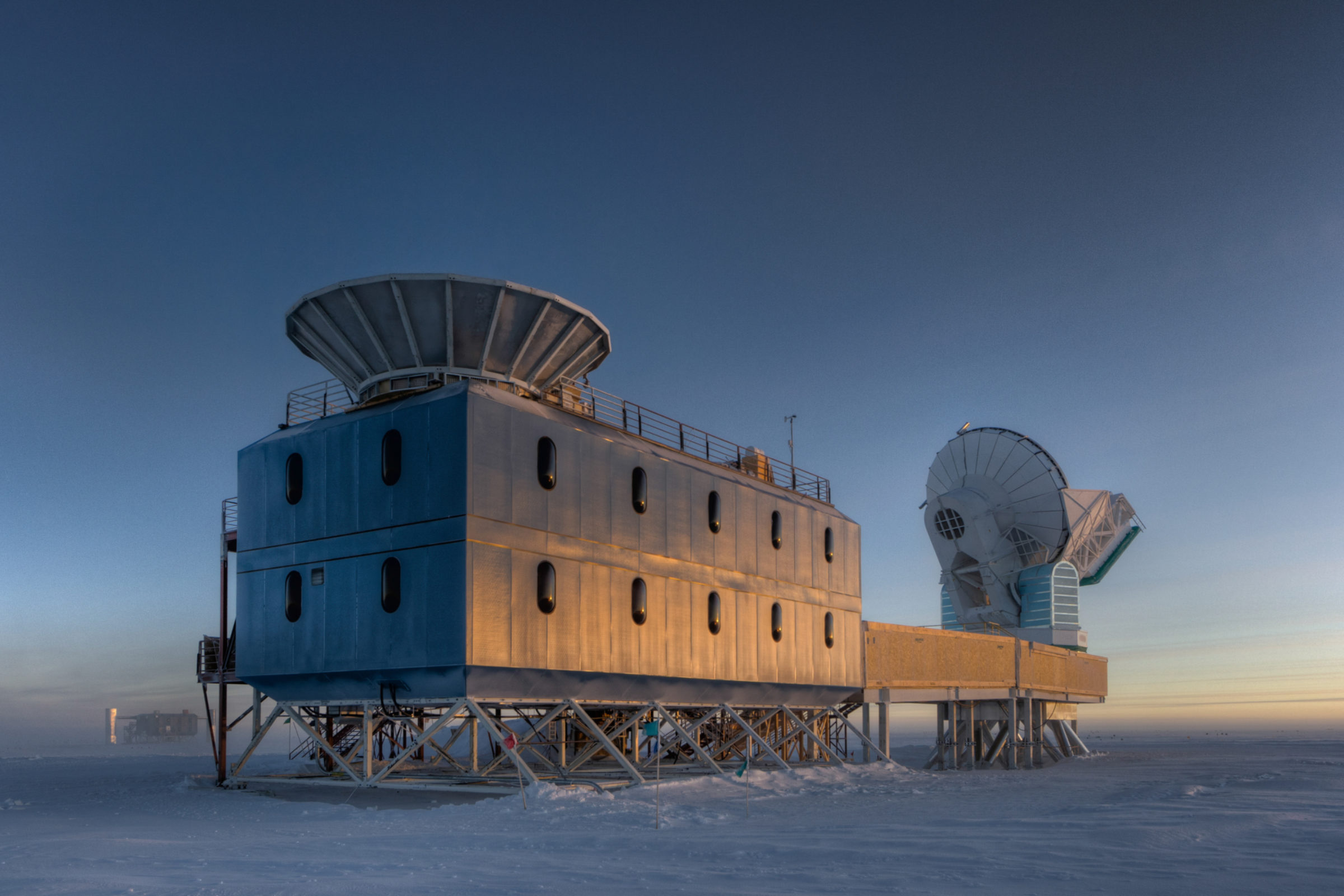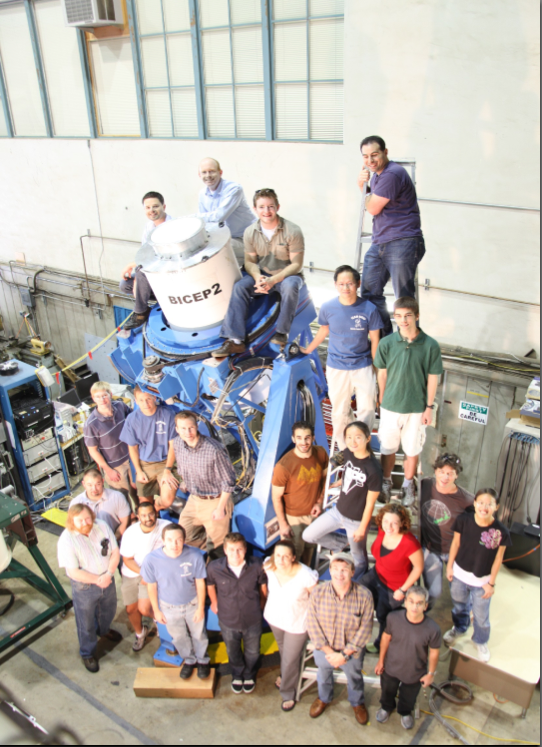Katherine Mack • Mar 25, 2014
Detecting Spacetime Distortions
It’s rare that a new discovery can stop an astrophysicist in their tracks and leave them lost for words. We’re used to media hype around results that are not really all that big a deal, and usually, by the time something hits the news, it’s already been digested (and often dismissed) by the astrophysics community. The BICEP2 detection of primordial gravitational waves, though -- that was different. It completely rewrote the agenda for every journal club, group meeting, hallway conversation, and seminar series for a week.
Rumors had been flying for several days before the announcement was made. The Harvard Center for Astrophysics put out a press release saying they would announce a “major discovery” on March 17. Physicists and astronomers speculated in all directions, but the one rumor that persisted was that a microwave telescope at the South Pole called BICEP2 had seen the signal it was looking for: minute distortions of spacetime set down in the first tiniest fraction of a second, as the universe was just coming into being.

I should start at the beginning. The very beginning. The big bang. When you think of the big bang, you probably think of the big bang singularity, which is the everything-from-nothing idea that the whole universe began in a single infinitesimally small point and expanded out from that. The jury is still out as to whether or not that actually happened, but to a physicist, the big bang usually refers to the hot big bang, or the Big Bang Theory, which is as close to rock-solid as physics theories get. The hot big bang says that at early times, the universe was smaller, hotter, and denser than it is today. In fact, the TV show The Big Bang Theory describes it reasonably well in the theme song: “The whole universe was in a hot dense state, then nearly 14 billion years ago expansion started…” Ever since the 60s, we’ve had measurements of the afterglow of the “primordial fireball” – the light that’s been travelling to us since the universe was still hot enough to be filled with energetic plasma, a state that lasted about 380,000 years. When the plasma started to cool down, all that primordial fireball radiation began to flow freely through the universe, stretching out as the universe itself expanded. When that light reaches us today, it is in the microwave part of the electromagnetic spectrum, so it’s known as the cosmic microwave background.
The very existence of the cosmic microwave background, or CMB, coming from every direction in the sky, confirms the hot big bang model. We see it all around us because wherever you look, if you look back far enough, you’ll see back to the earliest times. It’s almost exactly the same temperature across the sky and has the same kind of spectrum as a piece of metal glowing in a fire, indicating that it really is just heat from a hot cosmos. But tiny imperfections in the CMB tell us a great deal more. We can see fluctuations in the light from areas of higher and lower density – these tiny fluctuations at one part in 100,000 are the seeds that grow up via gravitational collapse to be the galaxies and clusters we see in the present-day universe.

The fluctuations in the CMB have been studied intensely – most recently by the Planck satellite, which gave us the highest resolution image of the early universe ever produced. But the afterglow light carries even more secrets in the form of its polarization. Every photon of light has a polarization – a direction in which the electric field is oscillating. For the CMB, the direction of that polarization tends to be correlated with the “hot” and “cold” spots that indicate low and high density. Polarization directions that line up radially (like an asterisk) or tangentially (tracing a circle) around a density peak are called E-mode polarizations, and polarization lines that trace pinwheel patterns are called B-mode. (The names come from an analogy with electric fields and magnetic field lines, because magnetic field lines can have a “curl” and electric field lines can’t, but that’s really just a visual analogy that makes the physicists happy.)

B-mode polarization only comes from two sources: gravitational lensing (the bending of light around massive objects) or gravitational waves. We’ve seen B-modes from gravitational lensing before, but Monday’s announcement was the first indication of B-modes from gravitational waves. That is, primordial gravitational waves. Gravitational waves that happened before the universe even began to cool.
Seeing primordial gravitational waves is a REALLY BIG DEAL. If BICEP2’s discovery is confirmed by other experiments – we should have several more measurements within a couple of years – it means we have seen further back in time than ever before, by a huge factor. The CMB directly probes the end of the hot-plasma epoch, 380,000 years after the “bang” of the big bang. Primordial gravitational waves, on the other hand, were produced at a time when the universe was only 1 part in 1035 of a second old. Seeing them offers strong evidence for cosmic inflation, the idea that the very early universe went through a period of extremely rapid expansion, where space itself expanded faster than the speed of light. In the inflationary model, the hot and cold spots we see in the CMB are actually the result of tiny quantum mechanical fluctuations in the density of the primordial plasma. The same mechanism would create wiggles in spacetime that would produce the gravitational waves BICEP2 seems to have picked up. That means this signal isn’t just evidence for inflation (which is huge anyway), it’s also evidence for quantum gravity – the ability for gravity to act as both a wave and as a particle, the same way light can. Quantum gravity has been the holy grail of theoretical physics for a long time. We don’t have a complete theory for it yet, but evidence that it actually happens is a huge development.
This is what my colleagues and I are so excited about. We’ve spent the last week absorbing the news, analyzing the possibilities, and debating the implications in every way we can think of. There’ve been journal clubs, seminars, group meetings, Twitter chats, Facebook groups, phone calls, and enthusiastic gatherings in hallways. When I ran into a colleague on Monday morning and showed him the B-mode image on my phone, he stopped dead, held the phone, and just stared. He grabbed another passing colleague, who could hardly believe his eyes. It was like seeing the birth of the universe happen, all on my tiny little iPhone screen. It was like suddenly knowing what it looked like. It was one of those moments you realize that theoretical physics can actually tell us something real about the universe, and that something can be unbelievably profound.

Of course, I’d be remiss in my duties as a cosmologist if I didn’t mention the caveats. The first is that, of course, this is a new measurement. It needs verification and the signal could very possibly diminish significantly in the next couple of years, due to things like foreground subtraction and measurement tweaks. Even if the signal is real and is this strong, some major questions remain, because it doesn’t appear to be consistent with previous measurements: Planck should have seen some indication that these gravitational waves were there, unless inflation was more complicated than we thought. This tension with other results is a major worry for a lot of cosmologists, and it needs to be sorted out, though I think in general the agreement is that the gravitational wave signal won’t go away entirely. The more concerning thing is that we still don’t have a complete and consistent theory for inflation itself, in the sense that its underlying physical mechanism is still under debate. (Why did it start? How did it end? What governed the rate of expansion?)
Personally, I think the BICEP2 team did amazing work finding this signal, and I don’t think it’ll disappear. I don’t know if I’m yet completely convinced it’s from inflation, but I will say my confidence that inflation happened is a heck of a lot higher than it was last week. As a theorist, I’m excited to see where this all goes. Not for the Nobel Prizes, but for the chance to see into the very earliest time, and learn, in a quantitative and completely revolutionary sense, how this big beautiful universe began.
The Time is Now.
As a Planetary Defender, you’re part of our mission to decrease the risk of Earth being hit by an asteroid or comet.
Donate Today

 Explore Worlds
Explore Worlds Find Life
Find Life Defend Earth
Defend Earth

